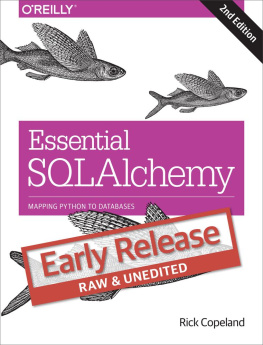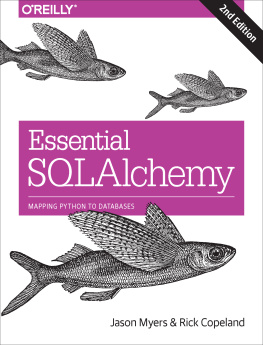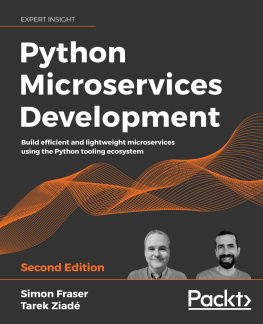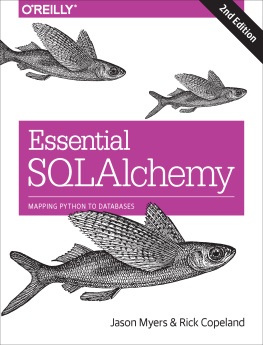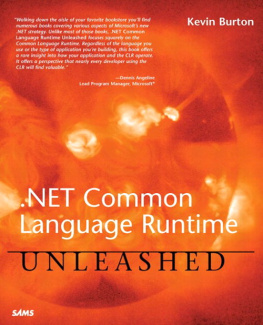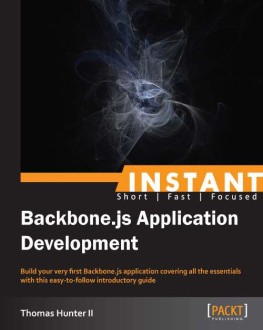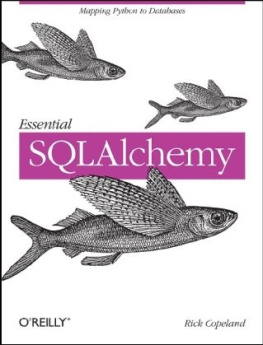Essential SQLAlchemy
Jason Myers
Rick Copeland
Beijing Cambridge Farnham Kln Sebastopol Tokyo
Preface
We are surrounded by data everywhere, and your ability to store, update, and report on that data is critical to every application you build. It doesnt matter if you are developing for the web, the desktop or other applications, they all need fast and secure access to data. Relational databases are still one of the most common places to put that data.
SQL is a powerful language for querying and manipulating data in a database, but sometimes its tough to integrate it with the rest of your application. You may have used string manipulation to generate queries to run over an ODBC interface, or used a DB API as a Python programmer. While those can be effective ways to handle data it can make security and database changes very difficult.
This book is about a very powerful and flexible Python library named SQLAlchemy that bridges the gap between relational databases and traditional programming. While SQLAlchemy allows you to drop down into raw SQL to execute your queries, it encourages higher-level thinking through a more pythonic and friendly approach to database queries and updates. It supplies the tools that let you map your applications classes and objects onto database tables once and then to forget about it, or to return to your model again and again to fine-tune performance.
SQLAlchemy is powerful and flexible, but it can also be a little daunting. SQLAlchemy tutorials expose only a fraction of whats available in this excellent library, and though the online documentation is extensive, it is often better as a reference than as a way to learn the library initially. This book is meant as a learning tool and a handy reference for when youre in implementation mode and need an answer fast .
This book focus the 1.0 release of SQLAlchemy; however, much of what will cover has been available for many of the previous versions. It certainly works from 0.8 forward with minor tweaking, and most of it from 0.5.
This book has been written in three majors sections: SQLAlchemy Core, SQLAlchemy ORM, and a Cookbook section. The first two sections are meant to mirror each other as closely as possible. We have taken care to perform the same examples in each section so that you can compare and contrast the two main ways of using SQLAlchemy. The book is also written so that you can read both the SQLAlchemy Core and ORM sections or just the one suits your needs at the moment.
Who This Book is For
This book is intended for those who want to learn more about how to use relational databases in their Python programs, or have heard about SQLAlchemy and want more information on it. To get the most out of this book, the reader should have intermediate Python skills and at least moderate exposure to SQL databases. While we have worked hard to make the material accessible if you are just getting started with Python, I would recommend reading Introducing Python by Bill Lubanovic or watching the Introduction to Python videos by Jessica McKellar as they are both fantastic resources. If you are new to SQL and databases check out Learning SQL by Alan Beaulieu. These will fill in any missing gaps as you work through this book.
How to Use the Examples
Most of the examples in this book are built to be run in a REPL (read, eval, print loop). You can use the builtin python REPL by typing python at the command prompt. The examples also work well in an ipython notebook. There are a few parts of the book such as [Chapter to Come], that will direct you to create and use files instead of a REPL. The supplied example code is provided in ipython notebooks for most examples, and python files for the chapters that specify to use them. You can learn more about ipython at its (website).
Assumptions This Book Makes
This book assumes basic knowledge about Python syntax and semantics, particularly versions 2.7 and later. In particular, the reader should be familiar with iteration and working with objects in Python, as these are used frequently through out the book. The second section of the book deals extensively with object-oriented programming and the SQLAlchemy ORM. The reader should also know basic SQL syntax and relational theory, as this book assumes familiarity with the SQL concepts of defining schema and tables along with creating SELECT, INSERT, UPDATE, and DELETE statements.
Conventions Used in This Book
The following typographical conventions are used in this book:
Italic Indicates new terms, URLs, email addresses, file names, and file extensions. Constant width Used for program listings, as well as within paragraphs to refer to program elements such as variable or function names, databases, data types, environment variables, statements, and keywords. Constant width bold Shows commands or other text that should be typed literally by the user. Constant width italic Shows text that should be replaced with user-supplied values or by values determined by context.
Tip
This element signifies a tip or suggestion.
Note
This element signifies a general note.
Warning
This element indicates a warning or caution.
Using Code Examples
Supplemental material (code examples, exercises, etc.) is available for download at https://github.com/oreillymedia/title_title.
This book is here to help you get your job done. In general, if example code is offered with this book, you may use it in your programs and documentation. You do not need to contact us for permission unless youre reproducing a significant portion of the code. For example, writing a program that uses several chunks of code from this book does not require permission. Selling or distributing a CD-ROM of examples from OReilly books does require permission. Answering a question by citing this book and quoting example code does not require permission. Incorporating a significant amount of example code from this book into your products documentation does require permission.
We appreciate, but do not require, attribution. An attribution usually includes the title, author, publisher, and ISBN. For example: Book Title by Some Author (OReilly). Copyright 2012 Some Copyright Holder, 978-1-4919-1646-9.
If you feel your use of code examples falls outside fair use or the permission given above, feel free to contact us at .
Safari Books Online
Note
Safari Books Online is an on-demand digital library that delivers expert content in both book and video form from the worlds leading authors in technology and business.
Technology professionals, software developers, web designers, and business and creative professionals use Safari Books Online as their primary resource for research, problem solving, learning, and certification training.
Safari Books Online offers a range of plans and pricing for enterprise, government, education, and individuals.
Members have access to thousands of books, training videos, and prepublication manuscripts in one fully searchable database from publishers like OReilly Media, Prentice Hall Professional, Addison-Wesley Professional, Microsoft Press, Sams, Que, Peachpit Press, Focal Press, Cisco Press, John Wiley & Sons, Syngress, Morgan Kaufmann, IBM Redbooks, Packt, Adobe Press, FT Press, Apress, Manning, New Riders, McGraw-Hill, Jones & Bartlett, Course Technology, and hundreds more. For more information about Safari Books Online, please visit us online.

